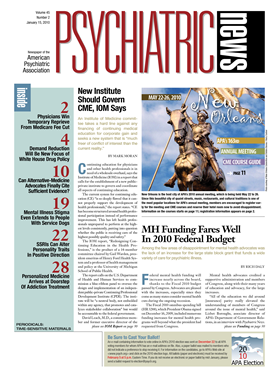The recovery model for mental illness has engendered a lot of talk in the last few years, but it remains at an early stage of incorporation into general psychiatric practice.
The recovery movement traces its origins to two sources, said Kenneth Thompson, M.D., medical director of the Center for Mental Health Services, an agency of the Substance Abuse and Mental Health Services Administration. One is an extended series of studies showing that most people with serious mental illnesses do not face inevitable deterioration or permanent disability. Over the long term, these studies showed, two-thirds of those individuals became symptom free or had only occasional problems connected with their illness.
Also, the consumer movement has made clear that many people with mental illness can manage their own illness and find a way to live in the general community if some additional resources (like housing or employment support) are available.
“Even with this model, it was hard to get people to imagine doing things differently,” said Thompson, in an interview with Psychiatric News.
Last fall, Thompson convened a conference to address how best to implement the recovery model (Psychiatric News, November 20, 2009).
“Our job now is to help develop practices and train people in the needed core competencies,” he said.
At least one psychiatrist has developed his own ideas on how to change systems of care to a more recovery-oriented focus.
For a start, everyone involved should be prepared for the long haul. Turning recovery from an idea into a way of life is a continuing process, said Long Beach, Calif., psychiatrist Mark Ragins, M.D. Ragins draws on his service as medical director at the MHA Village Integrated Service Agency in Los Angeles, as well as operations-research literature, to chart a plan by which clinics, hospitals, and mental health agencies transform into true recovery-based systems.
“Don't burn yourself out,” he said. “It's a marathon, not a sprint, and it will take a decade—at least.”
Like Learning a New Language
Traditionally, there are three ways of effecting change, said Ragins. “Development” is the practical approach, learning another tool to add to the box. “Transition” calls for creating a strategic plan, a vision for the future, and the road map for getting there.
“Transformation,” however, is like learning a new language, he said, in a talk at the APA Institute on Psychiatric Services in New York last October. Change the internal values and culture of an organization, and the new world view pervades its practice naturally.
“When you change how you look at things, it changes what you look at,” said Ragins.
To change, organizations need sustained, coordinated leadership. If leaders ignore an idea after the first flush of enthusiasm, those in the trenches will do so as well, until it dies forgotten.
Persistence also means creating learning cultures within programs.
“Sit down and talk about what you're doing, how well, and how you can do it better,” he said. “People have to think about changing. The alternative is top-down orders that meet resistance.”
Beware of Stifling Good Ideas
Improve the connection between those on the front lines and administrators—without the latter stifling the former.
Finally, hire consumers, he said. They “will see things differently than the staff does, and they'll shift the staff's views of people with mental illness too.”
Yet that can raise practical problems, said Thompson. Including peer-support workers may have clinical value, but incorporating them into standard mental health practice and billing for their services (because they are unlicensed) has proved challenging.
Of course, at the core of the recovery model lies the belief that at the center of the process rests the patient.
“The old paradigm was, ‘We treat illness,’” said Ragins. “Recovery means paying attention to the process the patient is going through. The driver is the person's life goals, rather than illness.”
That raises questions in the minds of some mental health practitioners, said both Ragins and Thompson.
“Some people see the recovery movement, because it shares the decision-making power with the patient, as a blow to professional autonomy and psychiatric practice,” said Thompson. “Some also see it as doing mental health care on the cheap. Others see a diminution of social control over the mentally ill and that more autonomy for patients would lessen constraints on dangerous individuals.”
Nevertheless, more people in psychiatry are recognizing why this movement has some merit and are incorporating it into their practices, he stated.
Ragins seems open to a more flexible system that reflects the patient's point of view.
“The first stage in recovery is building trust, not making a diagnosis,” he said. At a recovery-based clinic, the goal at the initial contact is not to open a file or write a treatment plan but to welcome and engage people at the level of their need.
“Let them drop in and do something that day,” he said. “If we can help them at that moment with whatever they need, it doesn't matter if they don't come back. Of course, we can also offer a referral and help them again if they want it.”
The reality of limited time and resources means that support ought to involve what the patient needs at that moment, whether it is treatment, skill building, or job training.
The “medical model” and the recovery model are frequently placed in opposition, but medication is part of recovery, said Ragins. “The best medical model would be a recovery model.”


